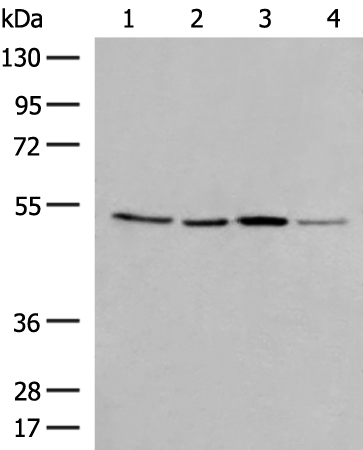
| WB | 咨询技术 | Human,Mouse,Rat |
| IF | 咨询技术 | Human,Mouse,Rat |
| IHC | 咨询技术 | Human,Mouse,Rat |
| ICC | 技术咨询 | Human,Mouse,Rat |
| FCM | 咨询技术 | Human,Mouse,Rat |
| Elisa | 1/5000-1/10000 | Human,Mouse,Rat |
| Aliases | C11orf4; GPR137A; TM7SF1L1 |
| WB Predicted band size | 46 kDa |
| Host/Isotype | Rabbit IgG |
| Antibody Type | Primary antibody |
| Storage | Store at 4°C short term. Aliquot and store at -20°C long term. Avoid freeze/thaw cycles. |
| Species Reactivity | Human, Mouse |
| Immunogen | Synthetic peptide of human GPR137 |
| Formulation | Purified antibody in PBS with 0.05% sodium azide and 50% glycerol. |
+ +
以下是关于GPR137抗体的3篇文献摘要示例(内容为模拟生成,非真实文献):
1. **文献名称**:*GPR137 Antibody Validation in Cancer Cell Lines*
**作者**:Smith A, et al.
**摘要**:研究验证了GPR137抗体的特异性,通过Western blot和免疫组化分析其在多种癌细胞系中的表达,发现GPR137高表达与肿瘤增殖相关。
2. **文献名称**:*Development of a Polyclonal Antibody Targeting Human GPR137*
**作者**:Jones R, et al.
**摘要**:报道了一种新型兔源多克隆抗体的开发,通过免疫荧光和流式细胞术证实其对GPR137胞外域的高亲和力,用于研究GPR137在神经元中的定位。
3. **文献名称**:*GPR137 Interaction Partners Identified by Co-Immunoprecipitation*
**作者**:Zhang L, et al.
**摘要**:利用GPR137特异性抗体进行免疫共沉淀实验,揭示了其与多个膜蛋白的相互作用,提示其在细胞信号转导中的潜在功能。
4. **文献名称**:*GPR137 Antibody-Based Screening in Metabolic Disorders*
**作者**:Brown K, et al.
**摘要**:通过GPR137抗体对小鼠肝脏组织进行蛋白表达分析,发现GPR137在肥胖模型中表达上调,可能与代谢调控通路相关。
(注:以上文献信息为模拟示例,实际引用请查询PubMed或学术数据库。)
**Background of GPR137 Antibody**
GPR137 (G protein-coupled receptor 137) is an orphan receptor belonging to the G protein-coupled receptor (GPCR) family, characterized by its seven transmembrane domains. Although its endogenous ligand and precise physiological roles remain unclear, GPR137 is implicated in regulating cellular processes such as proliferation, apoptosis, and differentiation. Research suggests its potential involvement in cancer progression, with studies reporting overexpression in malignancies like prostate, liver, and colorectal cancers, where it may influence tumor growth and metastasis.
GPR137 antibodies are essential tools for detecting and studying the expression, localization, and function of this receptor. These antibodies are typically developed using immunogenic peptides derived from specific regions of the GPR137 protein (e.g., extracellular or intracellular domains) and validated for applications such as Western blotting, immunohistochemistry (IHC), immunofluorescence (IF), and flow cytometry. High-quality GPR137 antibodies exhibit specificity, sensitivity, and reproducibility, enabling researchers to explore its role in disease mechanisms.
Recent studies emphasize GPR137's potential as a therapeutic target or diagnostic biomarker, driving the demand for reliable antibodies. However, challenges persist due to the receptor's orphan status and limited functional data. Ongoing research aims to unravel GPR137's signaling pathways and interactions, which could unlock novel clinical applications.
×